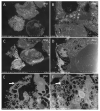Innovative Approach to Fast Electron Microscopy Using the Example of a Culture of Virus-Infected Cells: An Application to SARS-CoV-2
- PMID: 34073053
- PMCID: PMC8228702
- DOI: 10.3390/microorganisms9061194
Innovative Approach to Fast Electron Microscopy Using the Example of a Culture of Virus-Infected Cells: An Application to SARS-CoV-2
Abstract
Despite the development of new diagnostic methods, co-culture, based on sample inoculation of cell monolayers coupled with electron microscopy (EM) observation, remains the gold standard in virology. Indeed, co-culture allows for the study of cell morphology (infected and not infected), the ultrastructure of the inoculated virus, and the different steps of the virus infectious cycle. Most EM methods for studying virus cycles are applied after infected cells are produced in large quantities and detached to obtain a pellet. Here, cell culture was performed in sterilized, collagen-coated single-break strip wells. After one day in culture, cells were infected with SARS-CoV-2. Wells of interest were fixed at different time points, from 2 to 36 h post-infection. Microwave-assisted resin embedding was accomplished directly in the wells in 4 h. Finally, ultra-thin sections were cut directly through the infected-cell monolayers. Our methodology requires, in total, less than four days for preparing and observing cells. Furthermore, by observing undetached infected cell monolayers, we were able to observe new ultrastructural findings, such as cell-cell interactions and baso-apical cellular organization related to the virus infectious cycle. Our innovative methodology thus not only saves time for preparation but also adds precision and new knowledge about viral infection, as shown here for SARS-CoV-2.
Keywords: SARS-CoV-2; electron microscopy; embedding method; microwaves; single-break strip.
Conflict of interest statement
The authors declare no conflict of interest.
Figures







Similar articles
-
Concentration of SARS-CoV-2-Infected Cell Culture Supernatants for Detection of Virus-like Particles by Scanning Electron Microscopy.Viruses. 2022 Oct 28;14(11):2388. doi: 10.3390/v14112388. Viruses. 2022. PMID: 36366486 Free PMC article.
-
Microwave-assisted tissue processing for same-day EM-diagnosis of potential bioterrorism and clinical samples.Micron. 2006;37(6):577-90. doi: 10.1016/j.micron.2005.11.015. Micron. 2006. PMID: 16843832 Free PMC article.
-
The Strengths of Scanning Electron Microscopy in Deciphering SARS-CoV-2 Infectious Cycle.Front Microbiol. 2020 Aug 19;11:2014. doi: 10.3389/fmicb.2020.02014. eCollection 2020. Front Microbiol. 2020. PMID: 32973730 Free PMC article.
-
Application of transmission electron microscopy to the clinical study of viral and bacterial infections: present and future.Micron. 2006;37(2):91-106. doi: 10.1016/j.micron.2005.10.001. Epub 2005 Nov 2. Micron. 2006. PMID: 16361103 Free PMC article. Review.
-
FIB-SEM as a Volume Electron Microscopy Approach to Study Cellular Architectures in SARS-CoV-2 and Other Viral Infections: A Practical Primer for a Virologist.Viruses. 2021 Apr 2;13(4):611. doi: 10.3390/v13040611. Viruses. 2021. PMID: 33918371 Free PMC article. Review.
Cited by
-
Control of CDH1/E-Cadherin Gene Expression and Release of a Soluble Form of E-Cadherin in SARS-CoV-2 Infected Caco-2 Intestinal Cells: Physiopathological Consequences for the Intestinal Forms of COVID-19.Front Cell Infect Microbiol. 2022 May 4;12:798767. doi: 10.3389/fcimb.2022.798767. eCollection 2022. Front Cell Infect Microbiol. 2022. PMID: 35601094 Free PMC article.
-
Microscopic observations of SARS-CoV-2 like particles in different oral samples.Eur J Oral Sci. 2022 Dec;130(6):e12903. doi: 10.1111/eos.12903. Epub 2022 Nov 20. Eur J Oral Sci. 2022. PMID: 36404273 Free PMC article.
-
Limited permissibility of ENL-R and Mv-1-Lu mink cell lines to SARS-CoV-2.Front Microbiol. 2022 Oct 12;13:1003824. doi: 10.3389/fmicb.2022.1003824. eCollection 2022. Front Microbiol. 2022. PMID: 36312916 Free PMC article.
-
Concentration of SARS-CoV-2-Infected Cell Culture Supernatants for Detection of Virus-like Particles by Scanning Electron Microscopy.Viruses. 2022 Oct 28;14(11):2388. doi: 10.3390/v14112388. Viruses. 2022. PMID: 36366486 Free PMC article.
-
Tropheryma whipplei escapes LAPosome and modulates macrophage response in a xenophagy-dependent manner.Autophagy Rep. 2025 Mar 11;4(1):2475527. doi: 10.1080/27694127.2025.2475527. eCollection 2025. Autophagy Rep. 2025. PMID: 40395986 Free PMC article.
References
-
- Goldsmith C.S., Ksiazek T.G., Rollin P.E., Comer J.A., Nicholson W.L., Peret T.C.T., Erdman D.D., Bellini W.J., Harcourt B.H., Rota P.A., et al. Cell Culture and Electron Microscopy for Identifying Viruses in Diseases of Unknown Cause. Emerg. Infect. Dis. 2013;19:886–891. doi: 10.3201/eid1906.130173. - DOI - PMC - PubMed
Grants and funding
LinkOut - more resources
Full Text Sources
Miscellaneous

